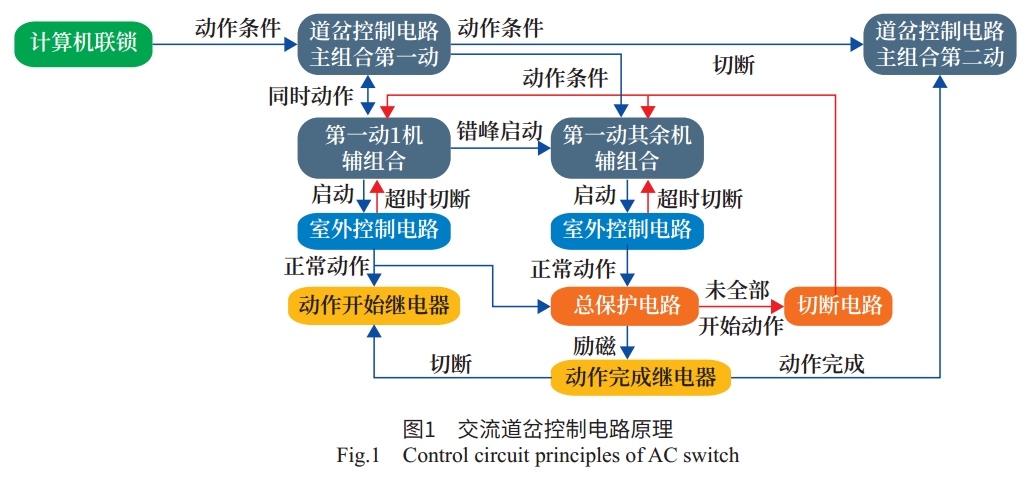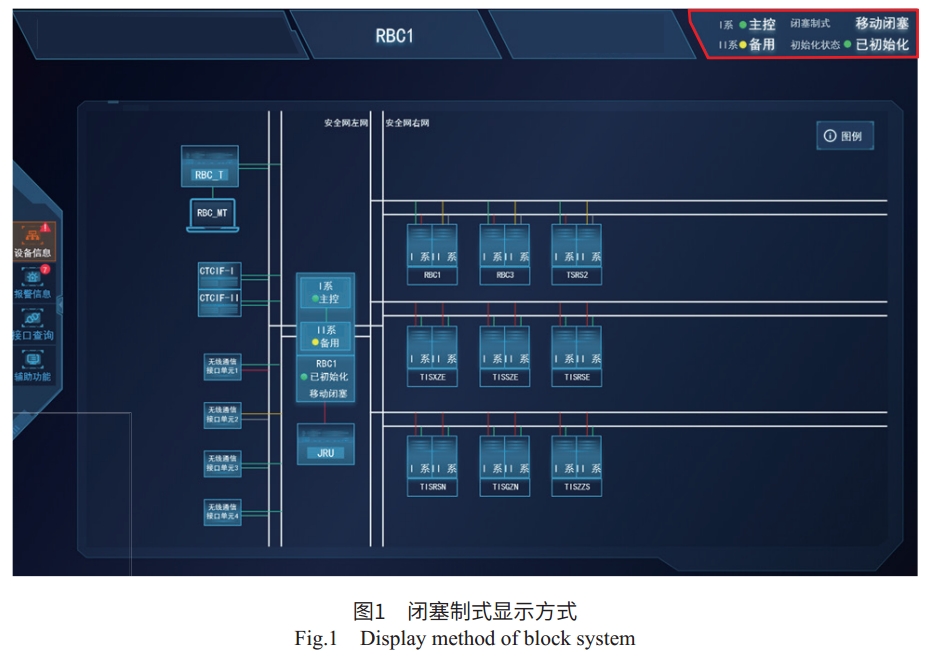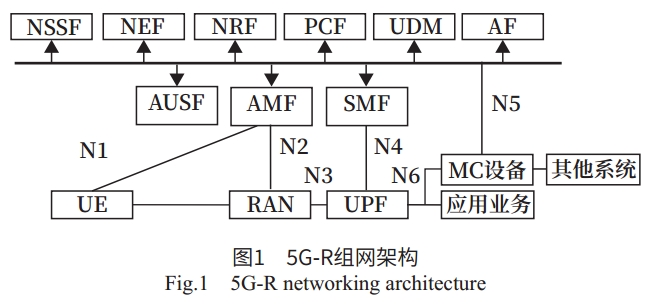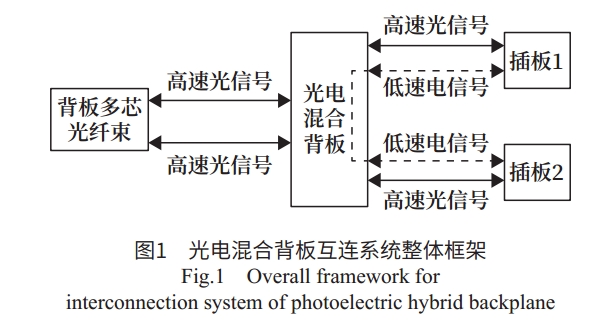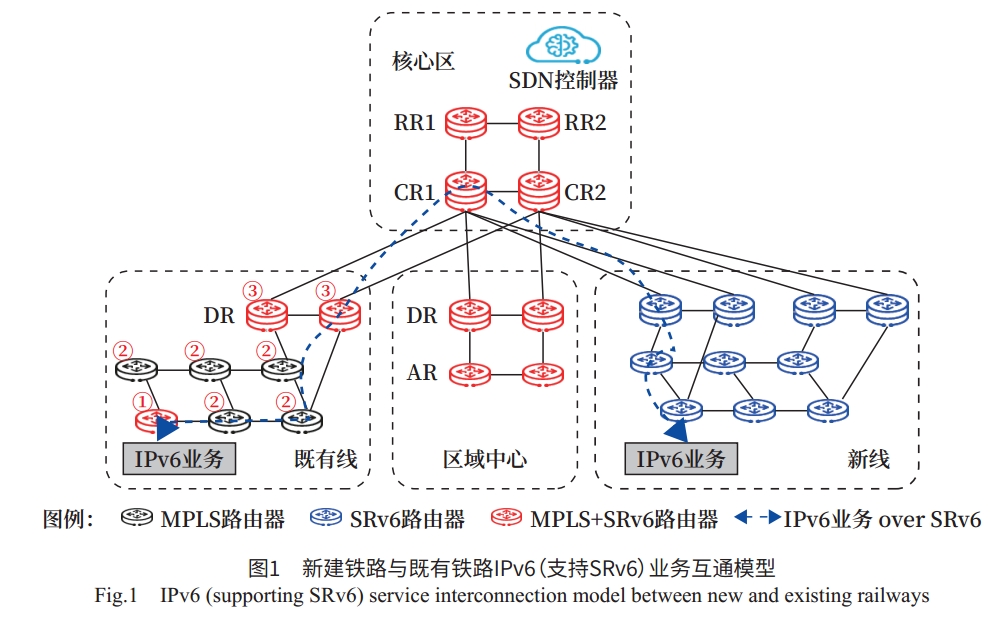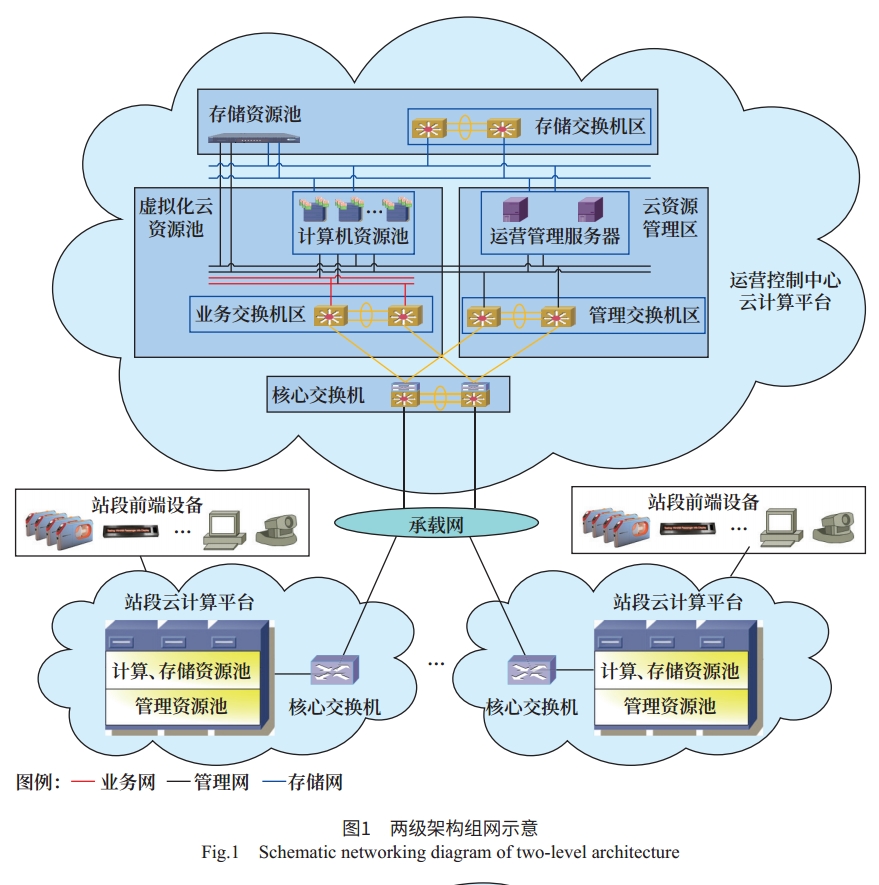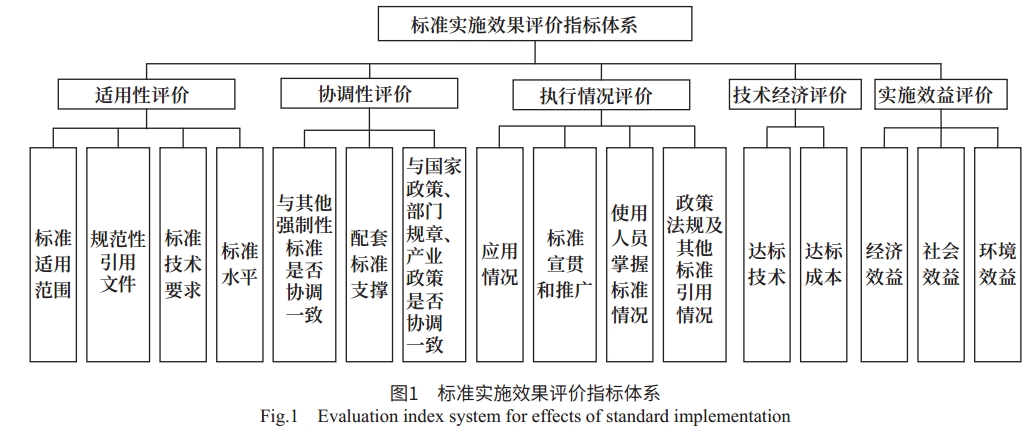Welcome to Railway Signalling & Communication Engineering,
Today is
中文
Current Issue
-
Research on Cooperative Train Control Based on Linear Quadratic Regulator
-
Ge Luming
-
2024 Vol. 21 (12):
1-8.
DOI:10.3969/j.issn.1673-4440.2024.12.001
-
Abstract (
)
PDF
(1849KB)(
)
-
With the continuous development of railway transport, improving the train operation efficiency has become a key goal of railway transport system optimization. This study is intended to propose a cooperative train control method based on Linear Quadratic Regulator (LQR), explore the effects of this method on cooperative train operation under the condition of control input delay, so as to improve the train operation efficiency, and conduct systematic assessment about the application effects of this method on cooperative train control through simulation study. Firstly, a mathematical model of tracking dynamics is established for the process of multi-train running, and an error model of the preceding and following trains is designed as the constraint of cooperative control. Secondly, an LQR controller is designed for cooperative train control. Finally, simulation tests are designed for the following train tracking the preceding train. The results show that the cooperative train control method based on LQR control can significantly improve the efficiency of multi-train cooperative operation.
-
-
Research on Differences of Control Circuit for Five-Wire AC Switch
-
Cui Yan, Xie Bocai
-
2024 Vol. 21 (12):
9-14,35.
DOI:10.3969/j.issn.1673-4440.2024.12.002
-
Abstract (
)
PDF
(1284KB)(
)
-
At present, there are some design differences in the control circuit for five-wire AC switch in stations with computer based interlocking, which causes inconvenience during the management and maintenance work of relevant bodies. By comparing and analyzing the circuit operation principles and requirements of the difference points in the control circuit, this paper puts forward circuit modification suggestions and design ideas from the perspectives of practical application, debugging and maintenance, which has positive value for a uniform standardized design of the control circuit for five-wire AC switch.
-
-
Discussion on Display Scheme for Maintenance Terminals of Central Equipment of New Train Control System
-
Cheng Yujia, Feng Kai
-
2024 Vol. 21 (12):
15-22.
DOI:10.3969/j.issn.1673-4440.2024.12.003
-
Abstract (
)
PDF
(2453KB)(
)
-
Compared with the CTCS-3 train control system, the new train control system provides some additional maintenance information. Targeting at such new information, this paper firstly proposes a display scheme for the maintenance terminals of the Radio Block Center and Temporary Speed Restriction Server on the basis of two published standard technical documents, i.e., TJ/DW228-2019 Temporary Technical Specification for Maintenance Terminal Display of Radio Block Center and TJ/DW227-2019 Temporary Technical Specification for Maintenance Terminal Display of Temporary Speed Restriction Server. It secondly describes the display method of block system, virtual section, axle counter, signal, balise and train information, specific calling-on train operation command, ground-based augmentation system and electronic map. It finally provides a brief description of the display functions and view classification provided by the maintenance terminal of IP Enquiry Server. It aims to unify the display interface and displayed information of terminal products, and to help standardize the operation and maintenance work of China’s railways
-
-
Study on Adaptive Modification Scheme of Signaling System Under Special Requirements of Train Operation Organization
-
Zhou Hailong
-
2024 Vol. 21 (12):
23-28.
DOI:10.3969/j.issn.1673-4440.2024.12.004
-
Abstract (
)
PDF
(1262KB)(
)
-
Proper train operation organization is an important guarantee to improve the station operation efficiency. As important equipment to ensure the train operation safety, the signaling system should be able to meet the needs of station train operation organization in route setting. In this paper, the Xinjie station of Baotou-Xi'an Railway is taken as an example. On the basis of the train operation organization adjustments proposed by the transport department, on-site verification and analysis are conducted to identify the problem in train operation organization after adjustments are made according to the current situation of existing stations. After research and traction calculation for train operation, the adaptive modification scheme of adding a route signal to the existing station signaling equipment is put forward to meet the special needs of train operation organization, which provides an idea for the future solution to such a problem, and provides technical reference for similar problems in engineering design.
-
-
Dynamic Management for Leading Locomotive Operation Based on CTC 3.0 System
-
Chen Xuan, Wang Jiannian, Li Huarong
-
2024 Vol. 21 (12):
29-35.
DOI:10.3969/j.issn.1673-4440.2024.12.005
-
Abstract (
)
PDF
(1243KB)(
)
-
Leading locomotive operation is a type of common and complex operation at hub stations. A new dynamic management scheme is designed to conduct operation management on the basis of the real-time records of leading locomotives, so as to solve the problems of the existing CTC3.0 system in term of management functions for leading locomotive operation at busy stations, such as frequent manual intervention, complex operations and poor practicability. The real-time record table for leading locomotives is dynamically maintained according to the real-time locomotive number and location at stations and the arriving and departing locomotive information in the train plan. During route setting, the dynamic programming method is adopted to automatically select the optimal running path and assist signalmen in selecting and setting shunting routes, by combing self-learning system path library with manual selection. Field application verifies that the proposed dynamic management scheme is more suitable for the actual requirements of busy stations, and can effectively improve system availability and reduce the workload of station operators.
-
-
QoS Test Method of Railway 5G-R Systems
-
Yin Yifan
-
2024 Vol. 21 (12):
43-47,120.
DOI:10.3969/j.issn.1673-4440.2024.12.007
-
Abstract (
)
PDF
(1171KB)(
)
-
Considering the introduction of 5G-R in the field of railway communication, this paper presents the development of railway mobile communication systems, studies the core network architecture of 5G-R, and explores the three major application scenarios in the railway domain. It also addresses the Quality of Service (QoS) requirements for service transmission links in specific railway scenarios, and establishes the test method for QoS performance indicators. This enables strategic planning to ensure the transmission rate, reliability and security of key core services in 5G-R communications and train control systems.
-
-
Research on Line Data Transmission Based on Region Wireless Communication
-
Cao Xiaoyu, Hu Xiaosheng, Gao Jie
-
2024 Vol. 21 (12):
48-56.
DOI:10.3969/j.issn.1673-4440.2024.12.008
-
Abstract (
)
PDF
(1940KB)(
)
-
In order to solve the problem of wireless loading of line data for heavy-haul railways and normal-speed railways and minimize the dependence on the coverage of wireless network, it is proposed that under the condition of wireless network coverage only at stations, the line data within the train path can be searched in real time according to the train running direction, train location, section length, turnout position and section locking direction, and accurately sent to the train in point-to-point mode. Under the condition that the section is not covered by wireless network, the prefabricated line data of the section is sent to the train in advance at the station in point-to-point fixed period. The on-board equipment judges the location of the estimated front end of the train, adopts the station line data or the section line data, and calculates the distance-to-go continuous speed curve according to the track circuit code to monitor the safe operation of the train. The proposed method effectively reduces the requirements of wireless communication range for line data loading, and reduces the implementation difficulty and investment cost of line transformation.
-
-
Research on Interconnection System for Photoelectric Hybrid Backplane in Railway Communication Platform
-
Ou Junfu, Wei Wen, Zhang Xin
-
2024 Vol. 21 (12):
57-61.
DOI:10.3969/j.issn.1673-4440.2024.12.009
-
Abstract (
)
PDF
(1224KB)(
)
-
To meet the requirements of high signal rate, large exchange capacity as well as high port rate and backplane interface exchange rate in the railway communication platform, this paper presents the design of an interconnection system scheme for the photoelectric hybrid backplane. It also introduces the overall implementation scheme of this interconnection method, the implementation scheme of various modules, and the communication process of high-speed signals and low-speed signals. The proposed interconnection scheme can solve the problems of the existing interconnection technology for the optical backplane, including fixed optical connection topology that cannot be changed at any time, separate application of electrical connector and optical connector, large space occupation and high cost.
-
-
Planning and Engineering Practice of IPv6 Deployment for Railway Communication Network of China Railway Shanghai Group Co., Ltd
-
Li Hong
-
2024 Vol. 21 (12):
62-68,96.
DOI:10.3969/j.issn.1673-4440.2024.12.010
-
Abstract (
)
PDF
(1613KB)(
)
-
Considering the application situation of the existing network and IPv4 addresses for railway communication of China Railway Shanghai Group Co., Ltd, this paper proposes a planning scheme on IPv6 deployment for the railway communication network of China Railway Shanghai Group Co., Ltd from the perspectives of IPv6 address allocation and "SRv6+MPLS" dual-stack technology. The proposed planning scheme is put into practice and applied in the construction of such new lines as Chizhou-Huangshan High-Speed Railway, Hangzhou-Wenzhou High-Speed Railway and Xuancheng-Jixi High-Speed Railway, enabling various new service systems to interconnect with the existing service systems through the IPv6 addresses and "SRv6+MPLS" dual-stack technology.
-
-
Method for Automatic Control of Level Crossing Signals
-
Shi Yuying, Fang Yafei, Zhang Honghua
-
2024 Vol. 21 (12):
69-75.
DOI:10.3969/j.issn.1673-4440.2024.12.011
-
Abstract (
)
PDF
(1324KB)(
)
-
The notification time for train approaching and the length of the train approaching notification section for the level crossing are determined on the basis of the time when the automatic driving container truck normally passes through the level crossing. Two information collection points for train approaching are set within the length of the approach section. The first information collection point of approaching section is set at the entrance of the approaching notification section, while the second information collection point of approaching section is set at the entrance of the emergency braking section of the level crossing. On the basis of the horizontal transportation system (VMS) and level crossing signaling system of the railway loading and unloading station of automated container terminals, a new signaling system of automated level crossing is installed for each railway level crossing. As a subsystem of the VMS system of the container terminals, it can enhance the safety control of the automated VMS system of the container freight yards on the traffic of the automated loading and unloading station, to ensure the traffic safety of the level crossings. Moreover, it can significantly improve the transport efficiency of roads and railways within the loading and unloading station.
-
-
Transfer Information System Between Automated Container Terminal and Railway Handling Line
-
Li Rui
-
2024 Vol. 21 (12):
76-80.
DOI:10.3969/j.issn.1673-4440.2024.12.012
-
Abstract (
)
PDF
(1141KB)(
)
-
By studying the transfer process of container arrival and the transfer process of container departure, this paper presents the design of a transfer information system between the automated container terminal and the railway handling line. The means of information exchange and system linkage are combined to solve the problems of the information transfer process during the transfer operation of the railway handling line connected to closed automated container terminal. The proposed system can significantly improve the efficiency and safety of the container transfer operation.
-
-
Research on System and Method of Decentralized Stopping for Vehicle Loading and Unloading Operations in Railway-Water Intermodal
-
Ma Xiaochen
-
2024 Vol. 21 (12):
81-88.
DOI:10.3969/j.issn.1673-4440.2024.12.013
-
Abstract (
)
PDF
(1429KB)(
)
-
The loading and unloading operations of various railway vehicles for railway-water intermodal transport are conducted at automated terminals. To achieve the stopping function of railway vehicles for port railways within the loading and unloading operation area, a decentralized and uniform stopping system for safety protection suitable for the characteristics of operational scenarios is designed to ensure the stable and safe loading and unloading operations of railway vehicles. In this research, the section positioning technology based on track circuit is adopted to determine the vehicle delivery and pickup processes based on the train occupancy and clearance time sequence in several track sections. Subsequently, the braking or release of the track stop device is controlled according to the needs of the process stage, enabling the stopping control of railway vehicles for railway-water intermodal transport. This enables a flexible and stable stopping state of railway vehicles within the loading and unloading operation area relative to any location of the gantry crane loading and unloading operations.
-
-
Research on Networking Scheme of Cloud Computing Platform for Urban Rail Transit
-
Chen Su, Zhao Sheng
-
2024 Vol. 21 (12):
89-96.
DOI:10.3969/j.issn.1673-4440.2024.12.014
-
Abstract (
)
PDF
(1352KB)(
)
-
This paper focuses on the main system architecture and disaster recovery scheme of the cloud computing platform for urban rail transit. It provides a detailed analysis of the advantages and disadvantages of various schemes from the aspects of safety and reliability, implementation difficulty, construction and operation cost, supporting facilities requirements as well as operation and maintenance management, and puts forward some reasonable suggestions for the networking scheme of the cloud computing platform for urban rail transit. Verification results show that the cloud computing platform for urban rail transit of two-level architecture features higher safety and reliability and has lower implementation difficulty during actual projects. However, external factors need to be considered for the system disaster recovery scheme, and a hierarchical deployment scheme should be adopted flexibly to maximize the advantages of various schemes.
-
-
Research on New AFC Ticket Checking Machine Based on Computer Vision Technology
-
Bian Yi, Li Aiqi
-
2024 Vol. 21 (12):
97-101.
DOI:10.3969/j.issn.1673-4440.2024.12.015
-
Abstract (
)
PDF
(1190KB)(
)
-
To solve the current problems of traditional gate-type automatic ticket machine (AGM), this paper proposes a new AGM based on the computer vision and artificial intelligence technologies. The new AGM collects image information within the monitoring scope through visual sensors. It accurately calculates and intelligently processes the received information through the traffic control module, thus accurately deriving the traveler or luggage location information. It controls the opening or closing of the blocking device through linked control between the main control unit and other modules. The new AGM achieves a slightly higher passenger traffic speed than the traditional gate-type AGM, and has such features as higher safety, low failure rate, and small floor space. It can be considered as a new AGM solution in engineering construction.
-
-
Impact Analysis of Section Faults in U888 Signaling System
-
Cai Bo
-
2024 Vol. 21 (12):
102-107.
DOI:10.3969/j.issn.1673-4440.2024.12.016
-
Abstract (
)
PDF
(1779KB)(
)
-
In the signaling system for urban rail transit, the Communication Based Train Control (CBTC) system is the main system for operating lines in China. For CBTC trains with normal train positioning and train-wayside communication, if a section fault occurs and the safety protection envelope of the downgraded train spreads to the faulty section, the faulty section will be considered by the interlocking system as occupied, so that the automatic clearing conditions of the route protection signal will not be met. Considering an actual case of section fault at Weiting Station on Suzhou Rail Transit Line 3, this paper analyzes the impacts of the protective envelope for train safety and the section fault when the brown and purple light strips are lit alternately to display the fault on the ATS interface. It also provides corresponding response measures and handling methods for operation and train management, which improves the efficiency of train operation commanding.
-
-
Treatment Scheme for Abnormal Pressing of Protection Button of Fully-Electronic 64D Module
-
Zhang Fusong, Xu Lanlan
-
2024 Vol. 21 (12):
108-114.
DOI:10.3969/j.issn.1673-4440.2024.12.017
-
Abstract (
)
PDF
(1436KB)(
)
-
This paper targets at the problem that the logic of the 64D semi-automatic block system of the departing station cannot be normally reset when the operator first mistakenly presses the block button and then presses the reset button after the train arriving at the receiving station that is equipped with the fully-electronic computer based interlocking and provided with the 64D semi-automatic block system for the inter-station section. It compares and analyses the logic of the 64D relay-based semi-automatic block circuit and the processing logic for semi-automatic block of the fully-electronic 64D module for semi-automatic block, to identify the cause of the problem. An optimized treatment scheme of the fully-electronic 64D module for semi-automatic block is proposed to deal with the case where the block button and reset button are pressed at the same time, which is intended to solve the problem that normal reset cannot be achieved at the departing station when both command buttons pressed at the receiving station, and the proposed scheme is tested and verified. The test results show that the proposed scheme achieves the desired effect.
-
-
Analysis and Optimization Measures for Rail Traction Current Return of Beijing-Tianjin Block Post
-
Liu Wenshun
-
2024 Vol. 21 (12):
115-120.
DOI:10.3969/j.issn.1673-4440.2024.12.018
-
Abstract (
)
PDF
(1124KB)(
)
-
This paper surveys the situation of existing rail traction current return of Beijing-Tianjin Block Post on Beijing-Shanghai High-Speed Railway, and analyzes the requirements and constraints of signaling and traction power supply related standards, specifications and products on rail traction current return. On this basis, it studies the factors that need to be considered for rail traction current return, and proposes the measures of minimizing current return breakpoints, shortening current return channels, and adding grounding wires and boosting cables on the basis of two conditions, i.e., ensuring smooth current return channels and avoiding the formation of a "third rail" that affects track circuit safety. In view of the actual situation of Beijing-Tianjin Block Post, it presents two schemes, i.e., connection through double-slip turnouts for current return and connection through horizontal connections for current return. After in-depth analysis and comparison, it finally proposes that direct connection on both sides of insulation for rail traction current return should be prioritized for railway block posts.
-
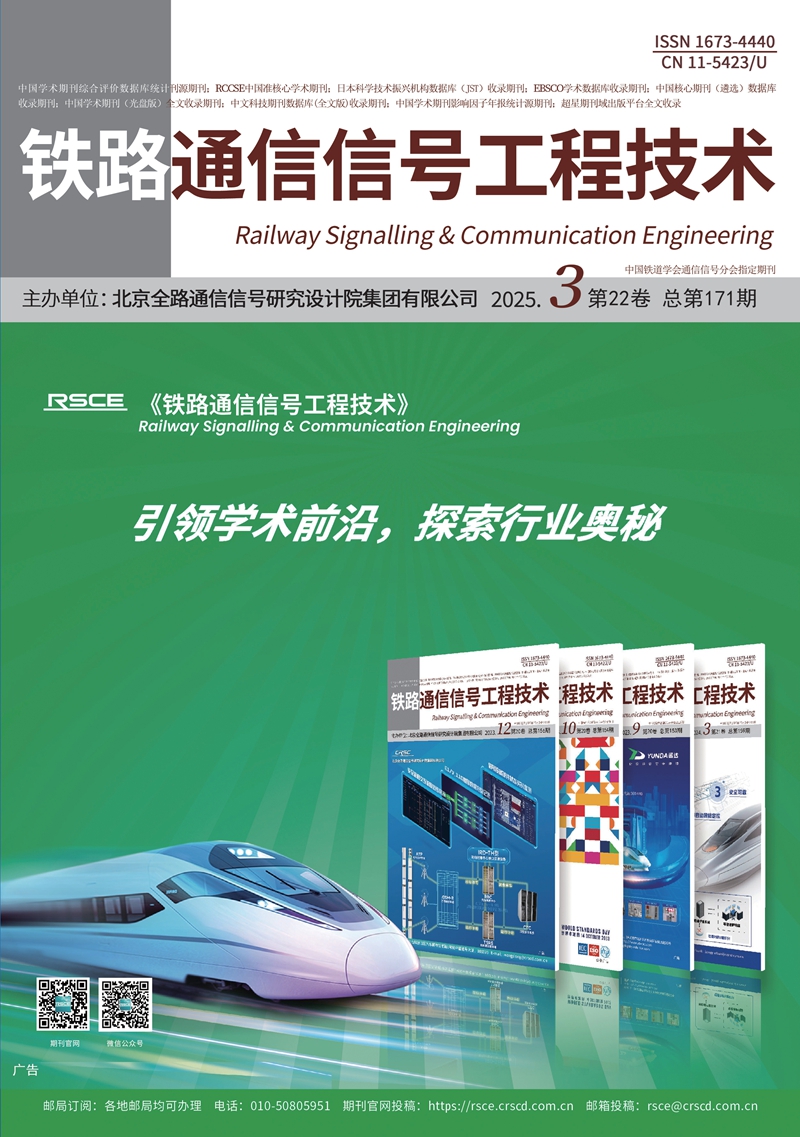
-
月刊
Monthly
-
第22卷 第3期 总第期
-
Vol.22 No.3 S.No.
-
出版:
2025-03-21
-
Published on:
-
创刊:2004 年
-
First Issue: 2004


